| Navigation : Previous | Next |
BPF and BPC Tools
This section details a set of important concept and tools. Among these, a number of function boxes allow to build or manipulate BPFs and BPCs. To access these tools, go to Functions / Basic Tools / Curves & Functions.
Online Documentation Reference
The online function reference provides more detailed information about the following (and more) functions, as well as different arguments. To refer to it, select a function and press d.
Getting Coordinates : Transfer and Point Coordinates
Point-Pairs : Points of the Curve
The ** point-pairs ** function returns the points of the curve as a list of (x y) coordinates.
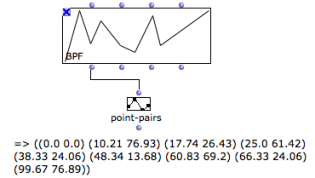 Point-pairs : list of (x y) points in the curve.
Point-pairs : list of (x y) points in the curve.
Transfer : Selected Points
Two transfer tools return the values of points that are not explicitly given in the curve.
-
” X-transfer” returns the ordinates for a given abscissa.
-
” Y-transfer” returns the abscissa values corresponding to given ordinates.
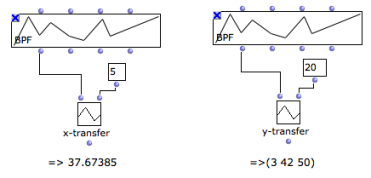 Transfers : x-transfer returns the y-coordinate for x=5. Y-transfer returns the various abscissa for y=20.
Transfers : x-transfer returns the y-coordinate for x=5. Y-transfer returns the various abscissa for y=20.
Sampling a Curve : Om-Sample
![]()
Sampling consists in creating a new curve of n regularly sampled points, out of an initial set of points.
Inputs
The om-sample function has two default inputs :
-
“self” : a list of points, BPF or BPC objects.
-
“sample-rate” : a number of samples in integers, or a sample-rate in floats.
It has three optional inputs :
-
“x-min” and “x-max” define a segment to sample within the curve.
-
“decimals” :
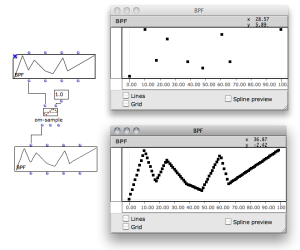 The sampling rate can be expressed as a float input to Om-samplezoom
The sampling rate can be expressed as a float input to Om-samplezoom
“sample-rate” input : Integer or Float
Be a curve whose min = 0 and max = 100.
- Integer :
n = 20we get 20 points, whose values are(0 5 10 15 20 25 30 35 .... 100). - Float :
SR = 20.0, we get 5 points, whose values are(0 20.0 40.0 60.0 80.0 100.0).
In any case n = (xmax - xmin) / SR
Outputs
Om-sample returns 3 values :
- a sampled object, such as a BPF , BPC …
- a list of x -coordinates
- a list of y -coordinates
Up-Sampling and Down-Sampling
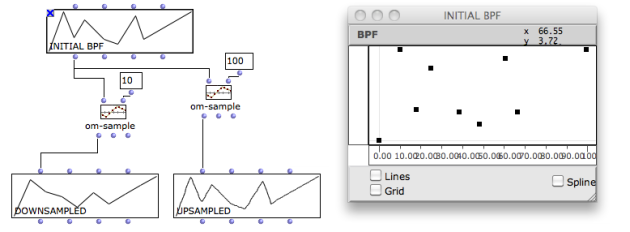
If n is lower than the initial number of points, curves are down-sampled. If n is higher, curves are up-sampled.
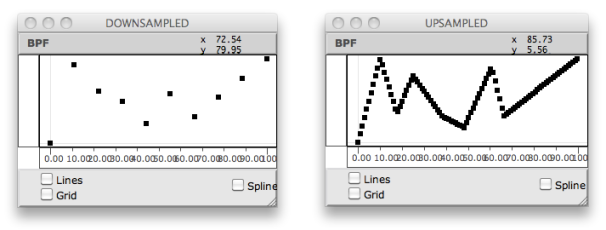
Splines : Om-Spline
![]()
Splines are mathematical functions defined piece-wise by polynomial interpolation. They are used for generating smoothed interpolated shapes , starting from a set of control points.
The om-spline function generates spline curves starting from the points of a BPF or BPC.
Inputs
-
“resolution” : a number of points in the spline preview.
-
“degree” : a number of adjacent control points used for computing the spline curve points. Higher values produce smoother curves.
Outputs
The three outputs of om-spline return :
-
a spline object (BPF, BPC…)
-
a list of x-coordinates
-
a list of y-coordinates
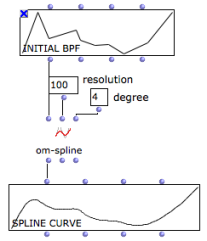
Spline Preview
The BPF and BPC editors allow to visualize a preview of the output spline object.
Spline Preview in the BPF/BPC Editors:
Contents :
- OpenMusic Documentation
- OM User Manual
- Introduction
- System Configuration and Installation
- Going Through an OM Session
- The OM Environment
- Visual Programming I
- Visual Programming II
- Basic Tools
- Curves and Functions
- BPF / BPC
- BPF/BPC-Libs
- Editors
- BPF / BPC Tools
- 3D Objects
- Array
- TextFile
- Picture
- Curves and Functions
- Score Objects
- Maquettes
- Sheet
- MIDI
- Audio
- SDIF
- Lisp Programming
- Reactive mode
- Errors and Problems
- OpenMusic QuickStart
| Navigation : Previous | Next |